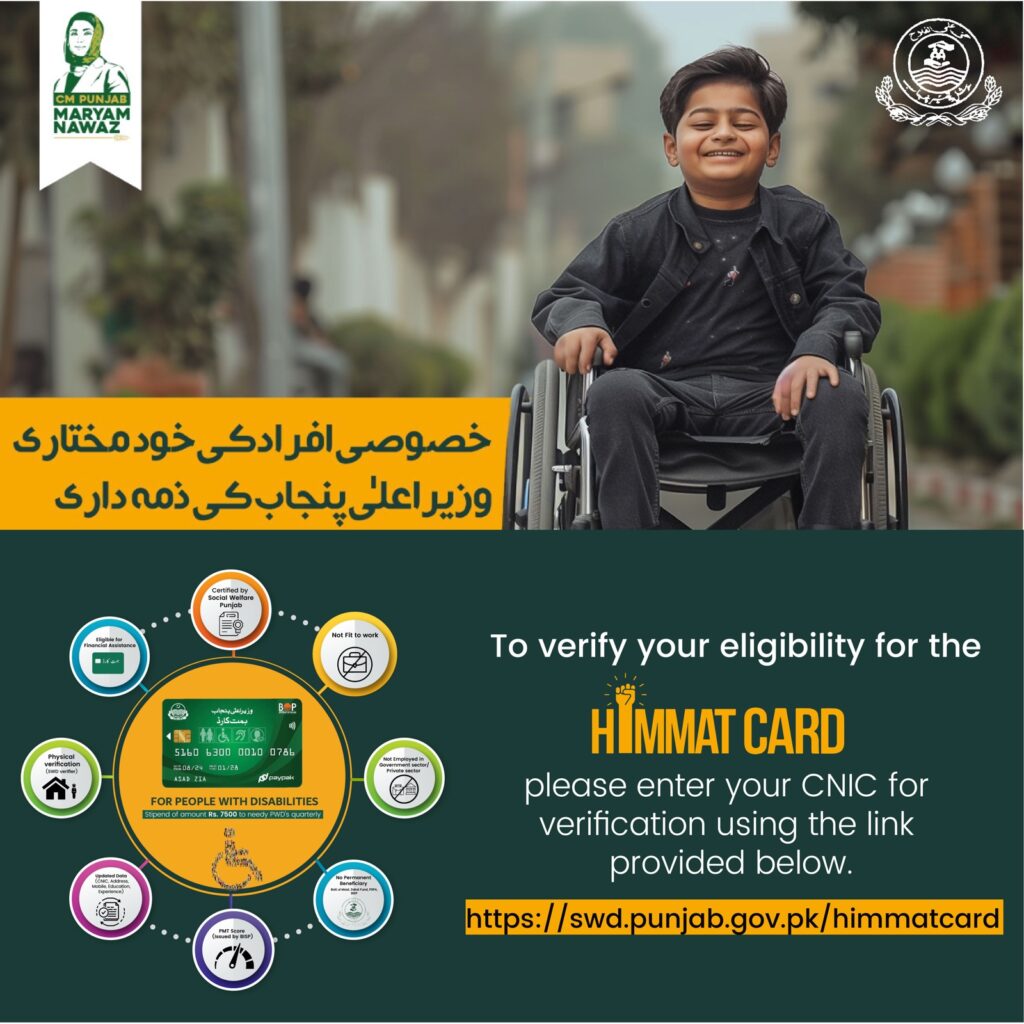Himmat Card Phase 1: A Ray of Hope for Persons with Disabilities in Pakistan
The true measure of a nation’s progress lies in how it treats its most vulnerable citizens — those who are weak, disabled, or marginalized. In Pakistan, millions of persons with disabilities (PWDs) have long faced barriers in education, healthcare, and basic facilities. Recognizing these challenges, the Government of Punjab has launched Himmat Card Phase 1, a transformative initiative designed to empower individuals with disabilities, helping them lead independent, dignified, and productive lives.
The Himmat Card is more than just a card — it represents dignity, inclusion, and the dream of a society built on equality and compassion.

Background of the Himmat Card Initiative
The Himmat Card has been introduced by the Punjab Social Protection Authority (PSPA), the body responsible for managing welfare and social protection programs across Punjab. This initiative aligns with international commitments such as the United Nations Convention on the Rights of Persons with Disabilities (UNCRPD) and the Sustainable Development Goals (SDGs), both of which emphasize equal rights and social inclusion for PWDs.
In its first phase, the focus is on identification, financial assistance, and access to essential services. By creating a unified and verified database under the Punjab Welfare Department, the government aims to ensure that every deserving individual is included in national welfare and development programs.
Objectives of Himmat Card Phase 1
The Himmat Card Phase 1 program is built around five key objectives:
1. Identification and Recognition
Developing a reliable provincial database of all persons with disabilities to ensure they are properly documented and included in government assistance programs.
2. Financial Support
Providing continuous financial assistance and essential living support to improve the quality of life for PWDs and reduce their dependency on others.
3. Access to Basic Services
Ensuring equal access to education, healthcare, transportation, and employment opportunities for all cardholders.
4. Social Inclusion
Encouraging communities to embrace people with disabilities as capable and equal members of society, breaking stereotypes and barriers.
5. Digital Efficiency
Using modern technology to deliver transparent, paperless, and corruption-free public services through smart systems linked to NADRA.

Key Features of Himmat Card Phase 1
The Himmat Card offers a range of benefits designed to meet the social, economic, and physical needs of persons with disabilities.
1. Monthly Financial Assistance
Each registered cardholder receives a monthly stipend of Rs. 7,500, enabling them to meet daily expenses with dignity and reduce dependence on family members.
2. Healthcare Services
Cardholders are entitled to free or subsidized healthcare, including physiotherapy, specialist consultations, and assistive devices like wheelchairs, hearing aids, and artificial limbs. This ensures that no individual is left untreated due to financial constraints.
3. Educational Opportunities
Disabled children and students are supported in continuing their education without financial worries. Scholarships, fee concessions, and skill-based training programs are provided under the Himmat Card to ensure inclusivity in education.
4. Employment and Skill Development
The scheme encourages both public and private institutions to offer job quotas and vocational training for Himmat Card holders. This promotes financial independence and helps them build sustainable careers.
5. Transportation and Mobility
To make travel easier, Himmat Card holders receive fare discounts on public transport. In some districts, special mobility vans have been launched to facilitate physically challenged individuals.
6. Smart Technology Integration
The Himmat Card is digitally linked to the NADRA database, making it a smart card that reduces paperwork and ensures transparency in verification and service delivery.
Eligibility Criteria
To ensure that the Himmat Card reaches the most deserving citizens, applicants must meet the following criteria:
- Must be a resident of Punjab province.
- Must have a certified medical board disability certificate.
- Must be registered with the Punjab Social Protection Authority (PSPA).
- CNIC is required for adults; B-Form for minors.
- Priority is given to individuals with physical, visual, hearing, or intellectual disabilities who are unable to earn a livelihood.
Application Process in Phase 1
The registration process for Himmat Card Phase 1 is designed to be simple and accessible, ensuring that persons with disabilities can apply without difficulty.
- Obtain the registration form from designated PSPA centers or local Social Welfare Offices.
- Submit the completed form with necessary documents to the relevant office.
- The applicant’s disability is verified by a government-approved medical board.
- Applicant details are cross-checked with the NADRA database to ensure authenticity.
- After verification, a Himmat Card is issued containing the individual’s name, CNIC number, and unique identification details.
This transparent, technology-enabled process not only simplifies access for applicants but also helps the government create a reliable database of beneficiaries.
For official information and updates, visit: https://smu.punjab.gov.pk/himmat-card

Benefits for Society
While the Himmat Card directly benefits persons with disabilities, its positive effects extend to society as a whole.
- Reduced family burden: The monthly stipend provides financial relief to families struggling to support disabled members.
- Economic empowerment: Education and employment opportunities transform PWDs into active, self-reliant citizens.
- Social change: The initiative challenges outdated stereotypes, encouraging equality and acceptance.
- Data-driven policy: With accurate statistics, the government can design more effective welfare programs in the future.
The ripple effect of inclusion and empowerment benefits not just individuals but entire communities.
Challenges in Implementation
Despite its success, Himmat Card Phase 1 has faced some challenges during rollout:
- Limited Awareness: Many deserving individuals were unaware of the program due to insufficient outreach.
- Documentation Barriers: Some applicants faced difficulties obtaining disability certificates or clearing NADRA verification.
- Accessibility Issues: Transport and infrastructure facilities in rural areas remain limited, restricting access for many applicants.
However, these challenges have provided valuable lessons for improving future phases of the Himmat Card initiative.
Conclusion
The Himmat Card Phase 1 is not just a welfare project—it’s a symbol of hope, dignity, and inclusion. By addressing the financial, educational, and social challenges faced by persons with disabilities, this program helps them live with greater independence and self-respect.
Although some hurdles remain, the launch of Himmat Card Phase 1 shows the government’s genuine commitment to building an inclusive and compassionate society. If expanded and strengthened in future phases, this initiative could transform thousands of lives, turning Pakistan into a more equal, empathetic, and empowered nation for all its citizens.



